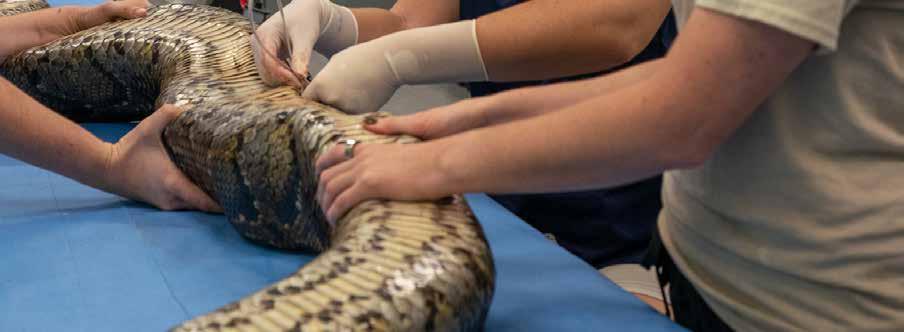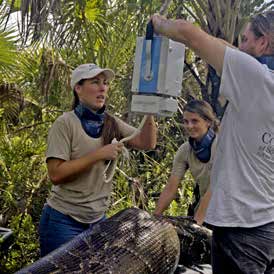Pythons in Paradise: A 21st Century Silent Spring
How one invasive predator is reshaping Florida’s ecosystem—and what local scientists are doing about it.

by Tim L. Tetzlaff, Director of Conservation,
Naples Zoo at Caribbean Gardens
In 1962, Rachel Carson’s Silent Spring warned of a world where DDT left landscapes intact but emptied them of life. Today, right here in Southwest Florida, we face a different kind of silence—not from chemicals, but from the invasion of Burmese pythons. Our trees still stand. Our wetlands still flow. But where native mammals once thrived, the landscape has fallen hauntingly silent.
The invasion began quietly. In 1979, when I was just eleven, what is now the Florida Fish and Wildlife Conservation Commission (FWC) recorded Florida’s first python in the wild. Few imagined the damage these invaders would cause in just decades. And ‘big’ doesn’t begin to describe them. Ian Bartoszek, wildlife biologist and Science Coordinator for the Conservancy of Southwest Florida, can attest to that. He and his team captured a python that shattered records, weighing 215 pounds and stretching nearly 18 feet in length— longer than a typical giraffe is tall. More alarming, it carried a record 122 developing eggs. Ian has documented deer over 75 pounds inside these giants. Most shocking is that a six-foot python—barely three years old—can swallow newborn fawns. It takes little imagination to consider the impact on Florida panthers who depend on deer for their food.
An Ecosystem Transformed This crisis extends beyond a few giant pythons. There are tens of thousands, and they’re often closer than we imagine. In areas populated with pythons, 15 of 16 studied mammal species have suffered dramatic declines: Marsh rabbits have been wiped out with raccoons and opossums barely hanging on. Bobcats dropped nearly 90%, facing the dual threat of losing their prey—and becoming prey themselves. With coordination by National Park Service biologist Matthew McCollister, Big Cypress National Preserve and the US Geological Survey continue to monitor these declines, build on past research, and track ongoing ecological shifts in areas impacted by pythons.
These losses may ripple up to us. With fewer raccoons and opossums, mosquitoes turn to cotton rats, a primary reservoir for Everglades virus. While human cases remain rare, University of Florida researchers have noted genetic mutations in the virus, prompting closer monitoring of potential human health effects.
Understanding Python Behavior With more than a quarter million dollars already invested into the Conservancy’s  groundbreaking research and python removal efforts, Naples Zoo is proud to support Bartoszek’s work and the “Sentinel Snake” method he’s refined. Because pythons are so elusive, male sentinel snakes with radio transmitters are used to locate and remove females. Along with numerous scientific publications, the Conservancy’s small team has removed over 36,000 pounds of pythons. No small feat—each pound carried out on the backs of this local team through extreme conditions.
groundbreaking research and python removal efforts, Naples Zoo is proud to support Bartoszek’s work and the “Sentinel Snake” method he’s refined. Because pythons are so elusive, male sentinel snakes with radio transmitters are used to locate and remove females. Along with numerous scientific publications, the Conservancy’s small team has removed over 36,000 pounds of pythons. No small feat—each pound carried out on the backs of this local team through extreme conditions.
As native wildlife populations plummet, the National Park Service and US Geological Survey team at Big Cypress studies python behavior to identify weaknesses that could improve removal efforts. With lessons shared from Conservancy’s pioneering work, they also track pythons with radio telemetry. In 2024 alone, Naples Zoo’s Dr. Kelsie Stovall performed 13 surgeries to implant radio transmitters. In the field, Dr. Stovall and staff have also x-rayed multiple pythons, confirming they had swallowed deer.
Bringing Back the Wild Supporting conservation efforts through Naples Zoo’s Conservation Fund—specifically earmarked for pythons at Naples Zoo. org/donate—directly funds removal, research, and habitat protection. Targeted equipment purchases can help keep boots on the ground when they’re needed most. And if you see a Burmese python, call the Exotic Species Hotline at 1-888-IVE-GOT1 (1-888-483-4681)
A Future of Florida’s Wildlife As dangerous as DDT ended up being, its health impacts have largely dissipated, and its persistence will decline even more over the next 100 years. Burmese pythons, however, will forever be a permanent part of the Florida landscape. These management efforts aim to help native wildlife survive this transition, in hopes that remaining populations adapt to a predator that was never part of their history. As little as we knew about what pythons would do when I was eleven, we know even less about what Florida will look like in 100 years. But whether you’re a longtime resident or new to the Paradise Coast, you can help restore hope for a landscape where Florida’s wild beauty endures. Balanced, thriving, and
alive for generations to come.
Contact me at tim@napleszoo.org To learn more or support these efforts, visit NaplesZoo.org/conserve
Together, we can create a brighter, more resilient future for people and wildlife.
 Naples Zoo at Caribbean Gardens is a private 501(c)(3) nonprofit entrusted with educating families and caring for rare species in a century old historic garden. Since 2014, Naples Zoo has invested over $3.5 million saving plants and animals in the wild and fully funds the annual salary of 27 field staff in 7 countries including three wildlife veterinarians. To learn more about how you can invest in a better future for people and wildlife, email tim@napleszoo.org.
Naples Zoo at Caribbean Gardens is a private 501(c)(3) nonprofit entrusted with educating families and caring for rare species in a century old historic garden. Since 2014, Naples Zoo has invested over $3.5 million saving plants and animals in the wild and fully funds the annual salary of 27 field staff in 7 countries including three wildlife veterinarians. To learn more about how you can invest in a better future for people and wildlife, email tim@napleszoo.org.




Leave a Reply
Want to join the discussion?Feel free to contribute!